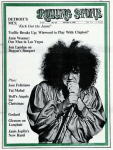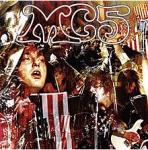 As the 60s crossed into the 70s, the Motor City 5 defined fire breathing, flame throwing rock and roll in Detroit. With Fred “Sonic” Smith and Wayne Kramer on the axes, Michael Davis on base, Dennis Thompson at the drums and the megawatt voice of singer Rob Tyner at the microphone, the band was the essence of proto-punk, rattling the rafters at the Grande and pushing the edge of the envelope everywhere they went.
As the 60s crossed into the 70s, the Motor City 5 defined fire breathing, flame throwing rock and roll in Detroit. With Fred “Sonic” Smith and Wayne Kramer on the axes, Michael Davis on base, Dennis Thompson at the drums and the megawatt voice of singer Rob Tyner at the microphone, the band was the essence of proto-punk, rattling the rafters at the Grande and pushing the edge of the envelope everywhere they went.
Such was their magnetism that they took over the cover of Rolling Stone magazine in January of 1969, even before the release of their debut album. In the magazine’s profile of the band, Eric Ehrmann, then a student at Miami of Ohio, called them “the next rock and roll superheroes“, the act that would symbolize the migration of musical revolution from San Francisco to Detroit. To hear the MC5 in live performance was like touching a raw nerve with a cattle prod. Rock journalist Robert Bixby famously called it “a catastrophic force of nature the band was barely able to control.”
 For those of us who grew up in Ann Arbor during the 5’s reign, the fact that you had to be 18 to buy their album at Jeep Holland‘s Discount records made them all the more alluring. Every Ann Arbor garage band had at least one MC5 song in our repertoire and we all dared one another to launch our version of “Kick Out The Jams” with Rob’s signature introduction.
For those of us who grew up in Ann Arbor during the 5’s reign, the fact that you had to be 18 to buy their album at Jeep Holland‘s Discount records made them all the more alluring. Every Ann Arbor garage band had at least one MC5 song in our repertoire and we all dared one another to launch our version of “Kick Out The Jams” with Rob’s signature introduction.
Then as now, rock and roll was a dangerous profession. Today, only Thompson and Kramer survive. But thanks to YouTube and MP3s, the MC5 experience is just as visceral and earthshaking today as it was during their brief prime. As Blade Runner character Eldon Tyrell might have said. “The light that burns twice as bright burns for half as long – and you have burned so very, very brightly.”

